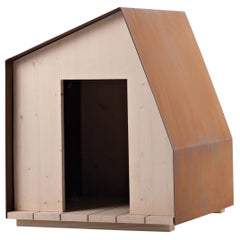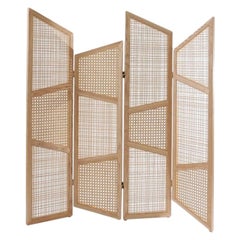DUPLEX Bird Cages
to
2
2
2
2
2
1
1
2
2
2
DeCastelli Nest House N.1 in Natural Corten by Filippo Pisan
By DeCastelli
Located in Brooklyn, NY
Our care for the environment around us can also be seen in the attention paid to our small friends in the animal kingdom. A small birdhouse can set the stage, with a structure that’s...
Category
21st Century and Contemporary Italian Modern Bird Cages
Materials
Fir
DeCastelli Dog House N°1 in Natural Corten by Filippo Pisan
By DeCastelli
Located in Brooklyn, NY
Dog House n°1 reinvents homes for our furry friends. Created as a version of Cottage n°1, it offers a conceptual revisitation of traditional kennels, focusing on the intrinsic charac...
Category
21st Century and Contemporary Italian Modern Bird Cages
Materials
Wood
Related Items
20th Century Louis Vuitton Suitcase In Natural Cow Hide, France c.1910
By Louis Vuitton
Located in Royal Tunbridge Wells, Kent
A highly unusual and exceptionally rare Louis Vuitton suitcase, originating from the early years of the 20th century, distinguishes itself not with the globally renowned monogram canvas but with a distinctive covering crafted from a singular piece of cowhide. This unique piece represents a special order from Louis Vuitton, showcasing the brand's historical commitment to utilising only the finest hides available.
Unlike many of its counterparts, leather trunks and cases of this era often struggle to withstand the test of time, requiring regular treatments to prevent drying and disintegration. Remarkably, this particular example defies the odds, retaining the same supple quality it possessed on the day it first graced the shop floor. This suitcase belongs to Louis Vuitton's collection of "speciality materials," which encompasses a diverse range, including, but not limited to, zinc, copper, crocodile leather, and cow leather.
A brief history about Louis Vuitton trunks: Louis Vuitton was born in 1821 to a farmer and milliner and came from a long-established working-class family in eastern France. Vuitton grew up understanding the effects of perseverance and a strong work ethic from watching his family. At the age of 16, he made the decision to walk 292 miles from his hometown to Paris to try and make a new life for himself. When he arrived the city was in the midst of industrialization with current modes of transportation evolving quickly allowing for longer journeys. With this came the need for sturdy travel pieces.
Vuitton was taken as an apprentice for a successful box maker and packer named Monsieur Marechal. He learned to craft durable containers and how to pack them properly – a well-respected profession at the time.In 1854, years after he had mastered his craft and became well respected for it, Vuitton ventured out on his own to open a shop on Rue Neuve des Capucines. It was here that he began to establish himself as a luggage maker. Then, in 1858, Vuitton designed the first Louis Vuitton steamer trunk. At the time trunks had rounded tops to allow for water to run off but this did not allow for convenient stowage. Vuitton introduced a flat, yet waterproof, trunk that was easily stackable. The first of his trunks were outfitted with a grey canvas referred to as Trianon – it wouldn’t be until several decades later that the signature monogram would be introduced.
With a burgeoning business, Vuitton moved his family and workplace to Asniere, where he employed twenty workers to craft his trunks. By 1900 he would have 100 employees, and in 1914 the company would more than double in size. After years of success, Vuitton began to experiment with the design of his luggage by introducing a new striped canvas pattern (1876) and later the still well-known Damier print (1888). The hand-painted patterns were developed to prevent counterfeits. Even in the late 1800s, Louis Vuitton was enough of a status symbol to warrant counterfeiting. In 1886, his son George invented and patented an ingenious locking system that made it impossible to pick the lock of their trunks. This lock is still used today.
1892 would prove to be a time of mourning for the family as Louis Vuitton passed...
Category
20th Century French Other Trunks and Luggage
Materials
Brass
$4,321
H 6.7 in W 25.99 in D 16.93 in
Contemporary Room Divider in Natural Cane Webbing
By Nada Debs
Located in NEW YORK, NY
This midcentury style partition is defined by its striking angles and play on texture.
The handmade room divider filters light while maintaining privacy and a separation of spaces.
M...
Category
Early 2000s Asian Mid-Century Modern Screens and Room Dividers
Materials
Straw, Cane, Ash
Postmodern House Bookends Memphis Milano 1980s
By Ettore Sottsass, Peter Shire
Located in San Diego, CA
Postmodern wood bookends. 1980s production in the Memphis Milano style. Retains the original 1984 label. USA
Category
Vintage 1980s Unknown Post-Modern Bookends
Materials
Wood
French Art Deco Cat & Dog Bookends, 1920
Located in Saint-Amans-des-Cots, FR
These charming French Art Deco bookends, dating from the 1920s, feature a noble combination of woods and brass, showcasing the elegant craftsmanship of the era. The cat and dog figur...
Category
Vintage 1920s French Art Deco Bookends
Materials
Brass
Art Deco style bookends cat and dog signed by Max Le Verrier.
By Max Le Verrier
Located in Antwerp, BE
Art Deco style bookends cat and dog signed by Max Le Verrier.
With foundry mark. Patinated Art Metal on Black marble base.
Design 1930.
Posthumous contemporary cast.
CHAT ET DOGUE....
Category
2010s French Art Deco Bookends
Materials
Belgian Black Marble, Metal
$1,456 / set
H 5.24 in W 4.34 in D 3.15 in
ClassiCon Folding Screen in White by Eileen Gray
By Eileen Gray
Located in New York, NY
The high-tech look that arose in the 1980s and which is still potentially current had an ingenious predecessor. Over half a century ago, Eileen Gray anticipated the cool industrial a...
Category
21st Century and Contemporary German Modern Screens and Room Dividers
Materials
Wood
Vintage Foo Dog Bookend Tray
Located in San Diego, CA
Vintage set of foo dogs mounted on a wood tray. These beautiful carved foo dogs rest on a conjoined tray that is ready for favorite titles or it can act a...
Category
Vintage 1960s Chinese Chinoiserie Bookends
Materials
Wood
Porcelain Foo Dog Lion Decorative Object or Bookend, Japan
Located in New York, NY
A beautiful white porcelain foo dog lion decorative object or bookend, circa early to mid-20th century, Japan. Foo dog lions, also known as komainu in Japan, are a symbol of good luc...
Category
Mid-20th Century Japanese Chinoiserie Bookends
Materials
Porcelain
Yoko Folding Screen in Natural Solid Oak
Located in Paris, FR
Folding Screen Yoko with 4 folding panels in solid oak wood in piano white lacquered finish.
manufacture of a plywood panel, 5 plies on touch hinges in p...
Category
21st Century and Contemporary French Screens and Room Dividers
Materials
Brass
Tori - Handcrafted Screen in Wood and Natural Cane Webbing
Located in Baguim Do Monte, PT
Tori Three-Panel Wood and Cane Screen Room Divider
The Tori screen is a handcrafted three-panel room divider that merges sculptural elegance with functional design. Its gently curve...
Category
2010s Portuguese Mid-Century Modern Screens and Room Dividers
Materials
Cane, Hardwood
Art Deco Cat & Dog Bookends, 1920
Located in Saint-Amans-des-Cots, FR
French Art Deco bookends, France, 1920s. Cat and dog. The Art Deco spirit at its best. A discreet cubism underlines the perfect lines of our two friends. Spelter and marble. Each - H...
Category
Vintage 1920s French Art Deco Bookends
Materials
Marble, Spelter
ClassiCon Folding Screen in Red by Eileen Gray
By Eileen Gray
Located in New York, NY
The high-tech look that arose in the 1980s and which is still potentially current had an ingenious predecessor. Over half a century ago, Eileen Gray anticipated the cool Industrial a...
Category
21st Century and Contemporary German Modern Screens and Room Dividers
Materials
Wood



